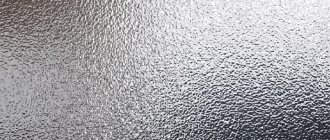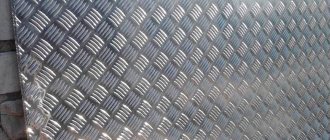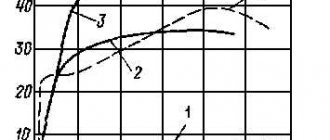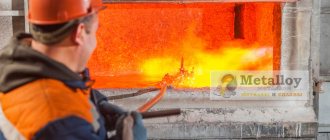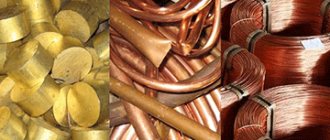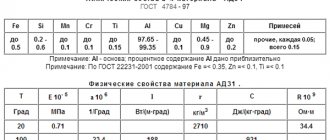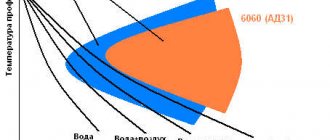Aluminum processing: types and features
Processing of aluminum blanks is possible in several ways, depending on the tasks and the desired result. Most often used:
- chemical polishing;
- electrochemical grinding;
- chemical oxidation.
Chemical polishing and its features
Chemical polishing can eliminate almost any visible surface defects without increasing its reflectivity. The essence of the procedure is that aluminum parts are immersed in a container with a special composition, under the influence of which the surface contour improves and irregularities become less noticeable. Before loading into an alkaline solution, all parts are thoroughly degreased.
Keep the parts in the solution for one to four minutes. The solution temperature is 100 degrees Celsius. After removal, all parts are thoroughly washed, first in hot and then in cold water.
Electrochemical grinding and its features
Most often, the BRYTAL method is used for electrochemical grinding of aluminum workpieces, the essence of which is that each part is first degreased, then carefully washed, and then immersed in an 80-degree solution containing sodium carbonate (15%) and trisodium phosphate (5%).
It is important to have a double impact here: first, by immersing the workpieces in the working solution for 20-30 seconds, the natural layer of aluminum oxide should be removed. After this, a 24-volt discharge is passed between the cathode and anode (which is the aluminum part), thus creating some kind of polarization.
The anode remains covered with an oxidized layer, which, in turn, is dissolved by the electrolyte over time. This takes him approximately the same amount of time as it takes to create, and the thickness of the layer does not increase.
Each part treated in this way is then dried. The result is a fairly thin oxidized layer. By itself, it is not a strong enough protection, and often requires subsequent anodization. As a result of this process, the surface of the workpieces acquires a reflective surface, which is valued, for example, in the manufacture of parabolic headlights. In addition, such products have a high level of wear protection.
Both chemical polishing and electrochemical grinding do an excellent job with the only task - improving the aesthetic properties of the surface. At the same time, the processed part does not have a high level of protection. Chemical and anodic oxidation are better suited for these purposes.
Chemical oxidation and its features
The effect of a chemical oxidizer on any aluminum part or alloy of this metal is very important from an economic point of view. First of all, the process must certainly take place before coating the products with varnish or paint, otherwise it is impossible to achieve the desired level of adhesion.
Additional benefits of chemical oxidation:
- increases resistance to corrosion;
- improves wear resistance;
- improves aesthetic qualities, including preservation of metallic luster.
The most popular chemical oxidation system includes the following steps:
- degreasing (the part is treated with trichlorethylene);
- washing each spare part in a large amount of hot and then cold water;
- immersing the workpieces in the working solution: 500 g of sodium carbonate and 150 g of sodium chromate are dissolved in 10 liters of water.
The holding time of spare parts in the solution is up to 15 minutes, the operating temperature is 90-95 degrees Celsius. After the aluminum is removed from the solution, each part must be thoroughly rinsed again in hot water and then in cold water.
During chemical oxidation, a thin film consisting of chromium and aluminum oxides is formed on the surface of the workpieces. It creates a good basis for coating with paint, varnish, and increases resistance to wear and corrosion processes.
How are aluminum alloys classified?
The classification of aluminum alloys occurs depending on the metal additives and is divided into:
The most common element in the earth's crust is aluminum. This is the thirteenth element of the periodic table. It is widely used in industrial production.
Other metals are added to an aluminum alloy in addition to the main element. Impurities are called alloying. This means that additional components are introduced into the alloy to give it some properties. Alloying elements can improve the physical or chemical properties of a material. An alloy is a mixture of aluminum-based metals with the addition of other elements. The content of the predominant metal should not exceed 99%.
- silicon (Si);
- magnesium (Mg);
- manganese (Mn);
- copper (Cu);
- zinc (Zn)
Iron can be considered an undesirable impurity because it reduces the strength of the alloy. But sometimes it is added specifically, for example, to make aluminum foil.
In addition to the main alloying elements discussed above, others are added to the alloy. They are included in small quantities up to 0.5%. These elements can add anti-corrosion, strength, and castability to the alloy.
Another basis for classifying aluminum alloys is the processing method. Alloys are distinguished:
- foundries;
- deformable.
In the first case, ready-made aluminum products are cast by filling out special molds. The alloy must have good fluidity in order to completely occupy the volume of the workpiece.
Wrought alloys are processed under pressure. They can be rolled, stamped or pressed.
Alloys using manganese have good strength. They are resistant to corrosion. This metal is easy to weld and is called duralumin, whose properties are highly durable.
Alloys with the addition of copper and silicon have a ductile structure, but are susceptible to corrosion. Therefore, they need to be coated with a protective metal. The use of aluminum alloys with copper occurs mainly in sleeve bearings and cylinder blocks.
Device cases are cast from alloys containing silicon, since the metal has little shrinkage.
Anodizing of aluminum parts
Anodizing is a process, also known as folk oxidation, that creates an oxide coating on the surface of an aluminum workpiece. In this case, aluminum is oxidized, but an oxide film protects it from oxidative processes.
This processing has a number of undeniable advantages:
- increases the protective and decorative properties of metal;
- provides surfaces with dullness and uniformity;
- eliminates mechanical damage such as chips, scratches, cracks;
- increases the thickness of the protective layer.
There are several types of processing of aluminum blanks by anodizing.
- Thermal anodization has a fairly simple technology; it is carried out at room temperature and allows you to obtain a beautiful color coating. In this case, only organic dyes are used. A skilled specialist can obtain several color schemes for the same part. Among the disadvantages, it should be noted that a high degree of protection against corrosion cannot be achieved.
- Cold anodizing of aluminum billets is characterized by the strength and hardness of the anode layer, excellent wear resistance, and high quality. Each part used within this technology must be well cooled. This treatment has the only drawback - it is impossible to use organic dyes during the cold anodizing process.
- A sufficiently strong and hard film can be obtained by hard anodizing. The peculiarity of the technology is the use of one of several electrolytes: in addition to sulfuric acid, oxalic, acetic, tartaric or boric acid is also used. During the process, the current density increases, and, accordingly, the film of increased density also increases.
For the anodizing process, several aluminum baths of different diameters are used (plastic or polypropylene can also be used). The main condition is compliance with the thermal insulation properties of the bath.
Aluminum in construction
Aluminum has a unique combination of properties that makes it suitable for many different types of products:
- pressed,
- rental,
- stamped,
- forged and
- cast.
Aluminum products can form complex systems for use in various spheres of life, including construction, mechanical engineering, and the production of recreational and sports products. Dozens of aluminum alloys make it possible to make maximum use of the advantages of aluminum to achieve maximum performance characteristics of aluminum products, such as:
- required dimensional accuracy;
- high level of strength;
- specified level of plasticity and viscosity;
- corrosion resistance under specified conditions;
- varied and attractive appearance;
- specified service life.
Therefore, aluminum is widely used as a material for building structures, such as:
- curtain facade systems;
- windows, doors and shop windows;
- roofing of industrial and civil buildings;
- elements of external cladding of buildings;
- furniture and furniture fittings.
Machining aluminum: what problems can you encounter?
Soft and ductile aluminum lends itself well to machining, but sometimes you can encounter negative effects. Some alloys have high viscosity. In this case, when milling or drilling, long chips may be formed, which will wrap around the working tool, causing it to break. To minimize the risk of such a problem, tools for machining aluminum alloys should be selected with large chip flutes - although this will limit the maximum number of teeth on the cutter, it will facilitate the flow of chips, partially solving the problem. We also do metal bending and metal laser cutting.
Properties of aluminum alloys and their applications
Aluminum alloys are widely used in aircraft construction and automobile production. Adding magnesium to the alloy improves the strength of the resulting metal. Finished products are easy to shape, since this property is practically not lost. In this case, the result of the work is not deformed. This material does not rust. This property makes it indispensable in shipbuilding. Anti-corrosion resistance is very necessary in the marine environment. Aluminum-magnesium alloys are used to make structures that are intended to be used in harsh weather conditions. For example, this material is indispensable in the construction of sea vessels and oil platforms. The properties of aluminum alloys make it possible to produce high-strength parts.
How to carry out turning correctly
In mechanical engineering, the share of lathes is up to 70% of metal-cutting equipment. Many parts are made on it. Turning is characterized by rapid rotation of the workpiece and a cutter fixed motionless on a support, moving along or across the axis of the rotating part. The result is cylindrical and conical parts.
Equipment and tools
On lathes, workpieces are processed by rotating them around a horizontal and vertical axis. The main tool used is cutters. All turning equipment is marked with the number “1” and is divided into 9 types, taking into account the features of the device.
The tool rotates using a special device on the caliper. Grinding and milling work is performed on a lathe.
Types of lathes
There are main types of lathes used in production:
- screw-cutting lathe;
- turning-turret;
- rotary turning;
- turning and grinding;
- lobotocar.
Screw-cutting lathes are the most widely used. They process long parts such as shafts and short cylindrical ones.
Carousels are used for the manufacture of bushings, rings and other large parts whose diameter is greater than their height.
Classification of incisors
According to the location of the cutting edge and the direction of movement of the caliper, cutters are divided into two types:
According to the shape of the working part:
- straight - the working part and the body have common lateral surfaces;
- bent - the cutting edge protrudes beyond the plane of the body and has a variable cross-section.
For external processing, types of cutters are used, named after the operations they perform:
- checkpoints;
- groove;
- shaped;
- threaded;
- boring
Lathe equipment is widely used for machining ends. At the same time, face and cutting cutters are installed on the caliper. In addition, the following are mounted on the tailstock:
- drill;
- countersink;
- taps;
- boring cutters.
There are certain geometric parameters of the cutter that are applied to the wedge. The cutting edge can be located at an angle to the direction of movement and perpendicular. For cutting tools - parallel to the axis of rotation.
Metal turning
Introduction of CNC
With the advent of CNC machines, the processing of parts with complex radial and involute surfaces has become much easier. Productivity has increased in the production of large batches.
Several operations are performed on one installation, including milling. The equipment may have 2 movable supports and several turrets.
Process Features
A distinctive feature of metal turning is the rotation of the workpiece and the stationary fastening of the cutter. This allows the production of shafts and other parts with a large number of cylindrical and conical surfaces.
Turning is a high-performance mechanical processing that provides high dimensional accuracy and good interaction of mating parts.
Processing modes
The metal processed by turning has various qualities: hardness, toughness, ductility. They all require different cutting angles and cutting speeds. Before issuing drawings for work, technologists make calculations of cutting conditions during turning. Based on them, normalization is made according to the time spent on performing each operation. Cutting modes include:
- spindle rotation speed;
- cutting depth;
- innings.
Quality and processing speed are opposite indicators when turning. They depend on the depth of cut and tool feed. The more chips removed in one pass, the greater the dimensional error and surface roughness.
Initially, rough turning is done - a large layer of metal is removed with a through cutter with an edge forming an acute angle to the axis of rotation of the workpiece.
Then a tool with a large contact area is placed on the surface to be processed and finishing is done - a thin layer of metal is removed with the side edge of the cutter and at the same time the ridges are smoothed with an edge located along the axis of the workpiece.
The softer the metal, the smaller the sharpening angle - the sharper the cutter. Cast iron and high alloy steels are processed with square plates. For aluminum and bronze, sharpening is done at 30⁰.
Turning technology
When processing on lathes, the cutter, moving along the workpiece, cuts into its surface. The cutting edge separates a narrow strip of metal - chips. The width and thickness of the chips are set by the machine operator.
Processing technology makes it possible to produce shafts with a large number of transitions and sizes. Moreover, all cylinders and cones are coaxial, since they were machined from the same installation. End drilling and other processing are done without reinstalling the part. The stationary tool is rigidly fixed, which allows the processing speed to be increased several times. TURNING FOR BEGINNERS / WHERE TO START?
Organic dyeing
Coating thickness from 5 to 25 microns.
Organic coloring is a technological process of applying various dyes to the anodized surface of aluminum. Organic dyeing produces a wider range of colors than conventional anodizing. Oxide films on aluminum and its alloys obtained by electrochemical anodization are characterized by high adsorption capacity. They absorb and retain mineral salts and organic compounds – dyes – well. Organic dyes color the film by adsorbing in its pores, mainly along their outer part. The most suitable organic dyes for coloring are oxide films formed in a sulfuric acid electrolyte. The purest tones are obtained by painting oxide films on aluminum and its alloys with magnesium or manganese. When oxidized, casting alloys such as silumin form a dark, spotted film, which cannot be painted in light colors and obtain a uniform color. Organic dyeing is used in the automotive, shipbuilding, aviation and furniture industries.
Aluminum cutting prices
Dural/Aluminium (AMTs, AMG)
| Metal thickness | Length of circuit up to 100 m | From 100 to 500 m | From 500 to 3000 m | Over 3000 m |
| 1 mm | 70 rub./m. | 57.5 rub./m. | 46.25 rub./m. | 46 rub./m. |
| 1.5 mm | 113.25 rub./m. | 78.75 rub./m. | 61.25 rub./m. | 33.75 rub./m. |
| 2 mm | 145 rub./m. | 102.5 rub./m. | 93 rub./m. | 47.5 rub./m. |
| 3 mm | 193.75 rub./m. | 157.5 rub./m. | 108.75 rub./m. | 61.25 rub./m. |
| 4 mm | 255 rub./m. | 193.75 rub./m. | 145 rub./m. | 81.25 rub./m. |
| 5 mm | 363.75 rub./m. | 255 rub./m. | 182.5 rub./m. | 102.5 rub./m. |
| 6 mm | 485 rub./m. | 363.75 rub./m. | 272.5 rub./m. | 152.5 rub./m. |
| 8 mm | 727.5 rub./m. | 546.25 rub./m. | 425 rub./m. | 237.5 rub./m. |
| 10 mm | 873.6 rub./m. | 727.5 rub./m. | 546.25 rub./m. | 306.25 rub./m. |
The minimum order cost for one operation is RUB 10,000. excluding the cost of materials. In case of a significant increase in the volume of a subsequent order, the amount is 10,000 rubles. included as a discount on your next order.
Specifics of bending aluminum sheet
Despite the soft structure and ductility of aluminum, when it bends at the point of impact, the same processes occur as in other metals.
Inside the corner, the metal is compressed in the longitudinal direction, and in the transverse direction, on the contrary, it is stretched. Outside, the exact opposite process occurs: transverse compression and longitudinal stretching. But only the outermost layers react to deformation in this way: the neutral layer between them remains calm.
When bending, a change in thickness also occurs: at the outer corner of the bend, the material “thinns”, but inside, on the contrary, it accumulates. All these processes are important when calculating bending parameters in relation to the dimensions of the workpiece. So, the greater its width, the less will be the influence of transverse deformation.
Features of cleaning from sunflower oil
A viscous liquid is a lipid mixture that does not interact with water. Therefore, other methods and means are used for removal. Substances are selected that can penetrate the fat molecules and remove them from the surface.
Mustard
The product is used in powder form. The bulk mixture is diluted with hot water. The proportion is as follows - for 1 liter of water take 2 tbsp. l. mustard powder. The ingredients are mixed so that there are no lumps, and the liquid is poured into the bottle up to the neck. After 2-2.5 hours, the liquid is drained and the container is rinsed with clean water. Repeated cleaning procedure will improve the effect.
Flour
The bulk mixture is used due to its ability to absorb various liquids. The bottle is completely filled with water, after which flour is added. The result should be a white liquid. The container is turned upside down so that the dirty places are covered with the solution. After a while, a handful of rice is added to the vessel. After shaking, the bottle is emptied of its contents. After washing the vessel with water and detergent, rinse.
Boiling
This method comes in handy if you have accumulated a lot of dirty containers and don’t have enough time to clean them. A large saucepan is filled with dirty vessels and filled with water to the very top. A small amount of detergent is added to the water.
The pan with the container is placed on the stove over medium heat. Boiling should be carried out for 25-35 minutes. After turning off the stove, leave the contents of the pan to cool. The container is taken out and washed with clean water. It is advisable to use a piece of laundry soap instead of detergent.
Drilling
Like other types of machining, aluminum drilling is performed at high speeds. When working with conventional drills, they must be sharpened in such a way as to reduce the required pressure on the material and achieve a better drilling result (Figure 3).
Figure 3 – Drilling aluminum [2]
Special drills for aluminum are used only for deep holes or soft alloys. Drills for processing extruded aluminum profiles have a sharpening angle of 130º, a helical flute angle of 40º, as well as special grooves for better chip removal [1, 2].
Method 2
To paint aluminum at home you will need:
- primer for aluminum, stainless steel and galvanized coatings - fine sandpaper - acrylic or epoxy zinc-aluminum paint for metal - white spirit, acetone or kerosene for degreasing the surface
Instructions for painting aluminum without anodizing
1 Thoroughly sand the surface of your aluminum product with fine sandpaper.
The less grainy sandpaper you use, the better. Size 600, 800 or 1200 is suitable 2 Degrease the surface using white spirit, acetone or a special degreaser 3 After complete cleaning and degreasing, coat the surface with a primer for aluminum and stainless steel as quickly as possible. If you leave aluminum treated with sandpaper in the air for a long time, then after a short time it will begin to darken - this is the result of the oxidation process, and primer and paint do not adhere well to oxidized aluminum. This is why it is so important to apply the first coat of primer as soon as possible. A few minutes later, after the first layer of primer has dried, you need to apply a second layer of primer for better adhesion of the paint to your product 4 Let's move on to painting. How to paint aluminum treated with primer? To do this, you will need a special zinc-aluminum metal paint containing zinc and aluminum. It is best to use paint in an aerosol can, since when applying paint from an aerosol can, it goes on much more evenly and smoothly than when applied with a brush. Before you start painting, shake the can thoroughly; paint should be applied from a distance of 25-30 centimeters. Painting should be done from top to bottom to avoid drips. After the first coat of paint has dried (20-25 minutes is enough), apply the next coat of paint. As a rule, for good and high-quality painting of aluminum, 3-4 layers of paint are enough. 5 After painting is completed, let your aluminum product dry completely. This requires 4 - 6 hours 6 You can additionally coat the product with varnish, this will add depth to the color and additionally protect the painted surface from damage. If you have followed all the steps of the instructions exactly, the new paint on your aluminum product will last for many years and look like new !
What affects the cost of the service
The calculation of the final price will be influenced by:
- urgency of the order;
- quantity, volume, dimensions of aluminum blanks, contour length;
- aluminum thickness;
- metal content in the alloy (%).
